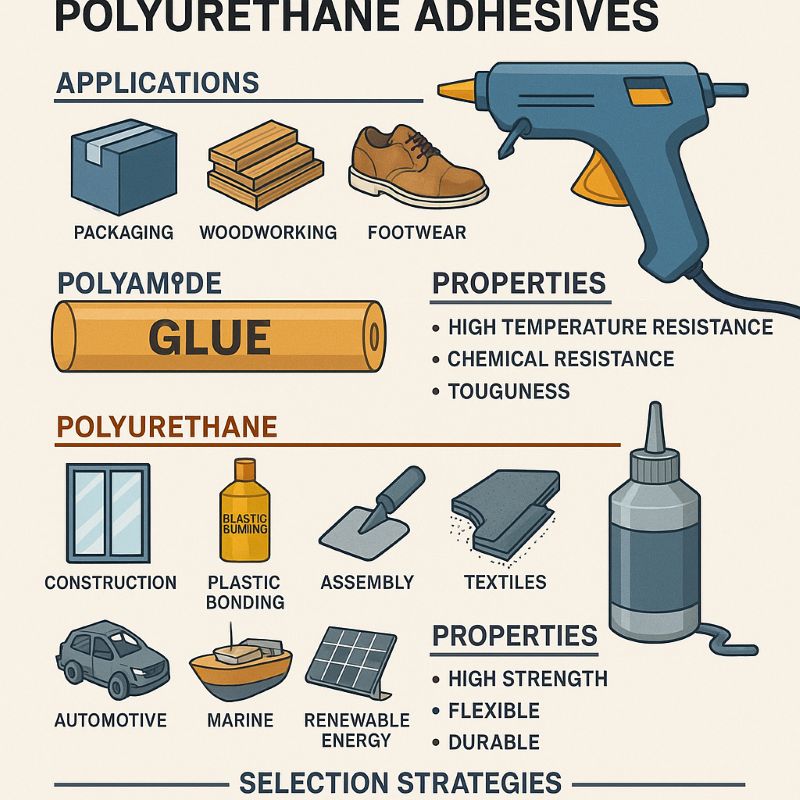
Thermoplastic Adhesives: Definition
Polyamide Adhesives: Types
Polyurethane Adhesives: Importance
Adhesive Application Methods
Comparing Adhesive Properties
Latest Trends in Adhesives
Adhesive Selection Strategies
Thermoplastic adhesives, commonly known as hot melts, are a class of adhesives that become moldable when heated and harden upon cooling, creating strong and durable bonds. These adhesives are known for their quick setting times and wide applicability across packaging, electronics, and consumer products. They are particularly valued for their ease of use and potential for reusability, making them ideal for operations requiring speed and flexibility.
Polyamide adhesives are recognized for their superior resistance to heat and chemicals. These adhesives come in two main categories: reactive and non-reactive. Reactive types chemically cure to form strong structural bonds, while non-reactive ones solidify by cooling. Compared to thermoplastic and polyurethane adhesives, polyamides are better suited for harsh environments where high temperatures or aggressive chemicals are involved.
Polyurethane adhesives are increasingly essential in applications demanding high flexibility, strength, and resistance to environmental stress. Unlike hot melts, which are optimized for speed, or polyamides, which emphasize durability in heat, polyurethane adhesives maintain bonding strength even under dynamic loads, such as vibrations or thermal expansion. This makes them ideal for construction, transportation, and composite bonding.
The application technique plays a key role in adhesive performance. Thermoplastic adhesives are typically applied with heated glue guns for speed and ease. Polyamide adhesives require carefully regulated heating systems to ensure optimal performance, particularly in precision electronic assembly. Polyurethane adhesives, by contrast, are often dispensed via caulking guns or two-part mixing systems to accommodate their curing properties and flexibility. Each method must align with the specific adhesive's characteristics and end-use requirements.
Each adhesive family brings unique strengths. Thermoplastics offer fast processing and reusability. Polyamides deliver resistance to extreme temperatures and chemicals. Polyurethanes provide unmatched elasticity and mechanical resilience, particularly under fluctuating environmental conditions. Selecting the right adhesive involves weighing these properties against the operational demands of the specific application.
Recent trends in the adhesive industry reflect a shift toward sustainability, functionality, and performance. Eco-conscious formulations are being developed to meet environmental regulations while maintaining bonding strength. Smart adhesives that change color upon curing are gaining traction for their role in quality control. Additionally, demand for adhesives that can withstand demanding mechanical and thermal conditions continues to drive innovation in polyamide and polyurethane technologies.
Strategic adhesive selection begins with a clear understanding of performance goals. Thermoplastic adhesives are suited for rapid, high-throughput environments. Polyamide adhesives are ideal for chemically or thermally challenging conditions. Polyurethane adhesives offer flexibility where components are exposed to movement, impact, or outdoor exposure. Aligning adhesive properties with application demands ensures efficient, long-term bonding performance.
What are thermoplastic adhesives?
They are adhesives that soften upon heating and harden upon cooling, offering fast processing and reworkability for industrial use.
What types of polyamide adhesives exist?
Polyamides are generally divided into reactive (chemically cured) and non-reactive (cooling-solidified) types, depending on application needs.
Why are polyurethane adhesives important?
They offer both flexibility and durability, ideal for applications exposed to stress, vibration, or shifting temperatures.
What are the common application methods for adhesives?
Thermoplastics are typically applied with glue guns, polyamides with heated systems, and polyurethanes with caulking or mixing tools.
How do adhesive properties compare?
Thermoplastics are fast and reusable, polyamides resist heat/chemicals, and polyurethanes flex with the material for long-term performance.
What are the latest trends in adhesives?
Trends include eco-friendly formulations, smart visual indicators during curing, and innovations tailored for lightweight and mobile structures.
What strategies should be used for adhesive selection?
Base your selection on thermal, mechanical, and environmental needs. Choose adhesives that match the application’s operational stresses.
Can you recommend specific adhesive products?
For legal and impartial reasons, specific brand recommendations are excluded. Users are encouraged to consult technical datasheets and application engineers to find the best fit for their needs.